Abstract
The paper presents investigations of changes in optical absorption and photo luminescence spectra of magnesium oxide, and natural and synthetic magnesium aluminium spinel related with the content of transition metal ions (Cr, Fe, Mn) and the irradiation with fast neutrons. Six synthetic single magnesium aluminium spinel crystals with different stoichiometry (MgO·nAl2O3), five natural crystals from Ural and Pamir deposits, and seven MgO crystals were studied. Micro impurities (Cr, Fe, and Mn) and macro component (Mg, Al) quantities have been determined using the instrumental neutron activation analysis technique. Concentrations of impurities in different spinels were found in following ranges: for Cr—1 × 10−4 to 8 × 10−2 %, for Mn—2 × 10−5 to 23 %, for Fe—1 × 10−4 to 1.2 %. Three ranges of luminescence: 380–460, 650–850 and 850–1,050 nm, were established in the most part of the investigated MgO samples. Analysis shows that the intensity of emission in each of these regions is strongly dependent on the concentration of transition metal ions. Great deviation from the stoichiometry of the irradiated MgO·2.8Al2O3 crystal leads to the local structure of α-Al2O3 formation around Cr3+ ions. The orange emission is attributed to Mn2+ in octahedral coordination, it can be assumed that the band at 570 nm is belonging to the complex centre “Mn2+–F+ (or F centre)”.






Similar content being viewed by others
References
Dolgov S, Karner T, Lushchik A, Maaros A, Mironova-Ulmane N, Nakonechnyi S (2002) Radiation Prot Dosim 100:127–132
Kvachadze V, Dekanozishvili G, Vylet V, Galustashvili MG, Akhvlediani Z, Keratishvili N, Zardiashvili D (2007) Radiat Eff Defec Solids 162:17–24
Gusmano G, Montesperelli G, Traversa E, Mattogno G (1993) J Am Ceram Soc 76:743–750
Wang CC (1969) J Appl Phys 40:3433–3444
Petermann K, Clausen R, Heumann E, Ledig M (1989) Opt Commun 70:483–486
Jouini A, Yoshikawa A, Brenier A, Fukuda T, Boulon G (2007) Phys Stat Sol (c) 3:1380–1383
Goulding RH, Zinkle SJ, Rasmussen DA, Stoller RE (1996) J Appl Phys 79:2920–2933
Oliveira Neto FF, Souza SS, Blak AR (1999) Rad Prot Dosim 84:139–142
Kazarinov YG, Gritsyna VT, Kobyakov VA, Sickafus KE (2002) Voprosi Atomnoi nauki i tehniki 83:53–57 (in Russian)
Okada M, Kawakubo T, Seiyama T, Nakagawa M (1987) Phys stat sol (b) 144:903–908
Hilbrandt N, Martin MJ (1999) Phys Chem B 103:4797–4802
Pascual JL, Savoini B, Gonzales R (2004) Phys Rev B 70:045109-1–045109-7
Nakatsuka A, Ueno H, Nakayama N, Mizota T, Maekawa H (2004) Phys Chem Miner 31:278–287
General requirements for the competence of testing and calibration laboratories (ISO/IEC 17025:2008)
Mironova N, Ulmanis U (1988) Radiation defects and iron group metal ions in oxides Zinatne, Riga (in Russian)
Soshea RW, Dekker AJ, Sturtz JP (1958) J Phys Chem Solids 5:23–26
Mironova NA, Rychkova SV, Skvortsova VN, Riekstinya DV (1987) Latv PSR Zinatnu Akad Vestis, Fiz tehn zin ser 3:36–40 (in Russian)
O`Neill MB, Gibson PN, Henderson B (1988) J Lumin 42:235–243
Acknowledgments
This work was supported by the Latvian Science Council Grant No. 402/2012 and ERDF project Nr.2DP/2.1.1.2.0/10/APIA/VIAA/010.
Author information
Authors and Affiliations
Corresponding author
Rights and permissions
About this article
Cite this article
Riekstina, D., Skvortsova, V. & Veveris, O. Application of INAA for investigation of magnesium and aluminium oxide materials. J Radioanal Nucl Chem 298, 1907–1911 (2013). https://doi.org/10.1007/s10967-013-2775-5
Received:
Published:
Issue Date:
DOI: https://doi.org/10.1007/s10967-013-2775-5




